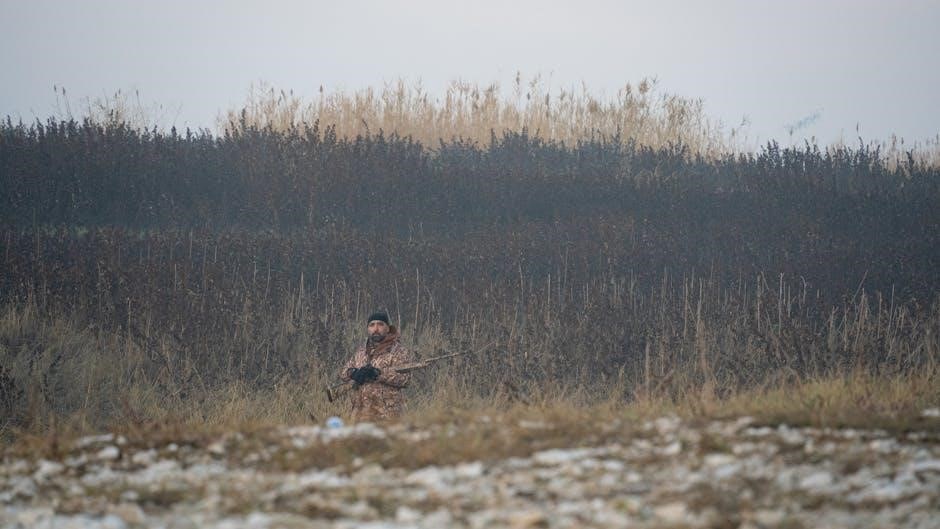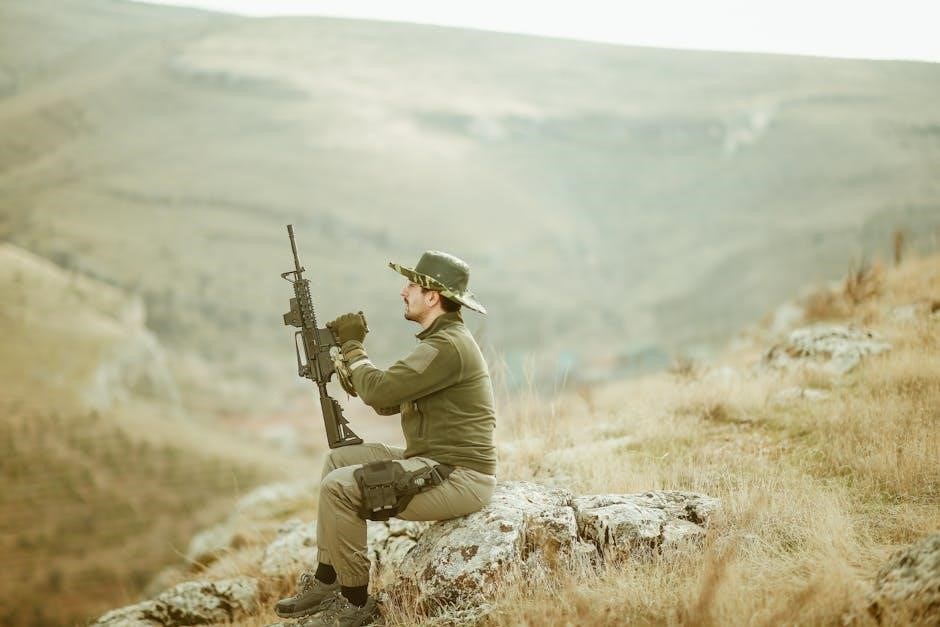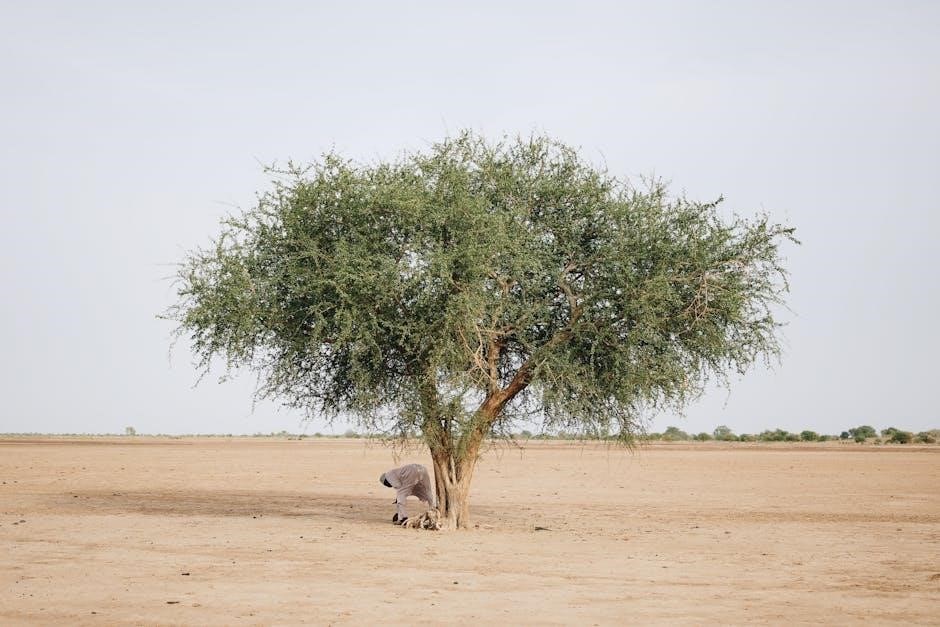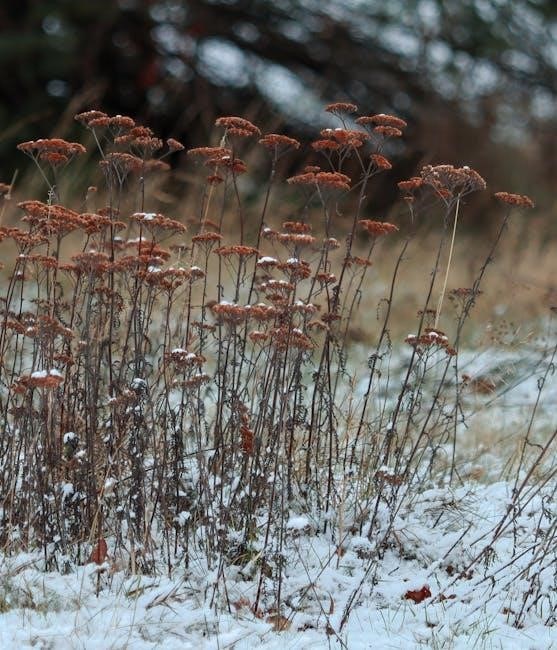Tom Brown’s Field Guide offers a comprehensive approach to wilderness survival, emphasizing connection with nature and practical skills for staying safe in the wild.
1.1 Overview of Tom Brown’s Field Guide
Tom Brown’s Field Guide to Wilderness Survival is a renowned resource that teaches practical skills for thriving in the wild. It emphasizes a deep connection with nature, blending traditional wisdom with modern techniques. The guide covers essential topics like shelter, water, food, and navigation, offering detailed instructions for various environments. Its holistic approach ensures readers understand the “why” behind survival methods, fostering confidence and self-reliance. With clear, accessible language, it remains a valuable tool for both novices and experienced outdoor enthusiasts, providing time-tested advice for wilderness challenges.
1.2 Importance of Wilderness Survival Skills
Wilderness survival skills are essential for staying safe and self-sufficient in nature. They empower individuals to navigate challenges confidently, whether lost in the woods or facing unexpected situations. These skills foster resilience, problem-solving, and a deeper connection to the environment. Mastery of survival techniques ensures preparedness for emergencies, promoting peace of mind. Tom Brown’s guide emphasizes that survival skills not only save lives but also encourage a harmonious relationship with the natural world, blending practicality with respect for the land.

Understanding the Wilderness Environment
Understanding the wilderness environment involves awareness of natural elements like terrain, vegetation, and wildlife. This knowledge is key to survival and living in harmony with nature.
2.1 Reading Nature and Landscape
Reading nature and landscape is a critical survival skill, involving observation of animal tracks, vegetation patterns, and water sources. By understanding these signs, one can locate resources, navigate, and avoid hazards. Recognizing game trails, bird flight patterns, and plant indicators helps in finding food and water. Additionally, understanding terrain features like ridges and valleys aids in orientation. This knowledge, as taught in Tom Brown’s guide, enhances situational awareness and fosters a deeper connection with the natural environment, essential for survival and thriving in the wild.
2.2 Understanding Weather Patterns
Understanding weather patterns is crucial for wilderness survival. Observing natural indicators like cloud formations, wind direction, and animal behavior helps predict changes. High-pressure systems often bring clear skies, while low-pressure systems signal storms. Recognizing these signs allows you to prepare for extreme conditions, such as building shelter before rain or finding shade in intense heat. Tom Brown’s guide emphasizes the importance of staying attuned to nature’s signals to stay safe and adapt to environmental changes effectively.

Shelter and Protection
Shelter and protection are vital for wilderness survival, shielding you from harsh weather, wildlife, and extreme temperatures while providing a sense of security and stability.
3.1 Finding Natural Shelters
Finding natural shelters is a key survival skill, utilizing resources like caves, rock overhangs, and hollowed logs. These formations provide protection from rain, wind, and wildlife. Observing the landscape for indentations, overhangs, and tree cavities can reveal hidden shelters. In snowy conditions, drifts or dugouts offer insulation. Always assess the structural integrity and potential hazards like falling rocks or flooding. Natural shelters conserve energy, offering immediate refuge without the need for construction, making them a vital part of wilderness survival strategies.
3.2 Building Your Own Shelter
Building your own shelter is a critical survival skill, requiring creativity and resourcefulness. Using natural materials like branches, leaves, and snow, you can construct lean-tos, debris huts, or snow shelters. Ensure the structure is sturdy, with a sloped roof to shed water and proper insulation for warmth. Consider drainage and wind direction to maximize protection. Reinforce the frame with sturdy poles and layer bedding for comfort. A well-built shelter provides safeguard against harsh elements and wildlife, enhancing your chances of survival in the wilderness.
Water Procurement and Purification
Access to clean water is vital for survival. Learn to identify natural sources, collect rainwater, and purify water using methods like boiling, filtration, and disinfection to ensure safety.
4.1 Locating Water Sources
Locating water is crucial for survival. Look for low-lying areas, valleys, and animal tracks, as these often indicate nearby water sources. Vegetation and bird activity can also signal water presence.
Check natural water sources like streams, rivers, and ponds, but be cautious of stagnant water. In dry areas, collect dew or rainwater, or dig shallow wells near dry stream beds.
Always test water sources for flow and clarity before use, ensuring they are safe and reliable for hydration.
4.2 Purifying Water for Safe Drinking
Purifying water is essential to avoid waterborne illnesses. Boiling water is the most reliable method, bringing it to a rolling boil for at least one minute to kill pathogens;
If boiling isn’t possible, use sand filtration or solar disinfection. Create a simple filter using sand, gravel, and charcoal to remove impurities.
Additionally, adding water purification tablets or natural elements like iodine can ensure safety. Always prioritize purifying water before consumption to maintain health in the wilderness.
Food Procurement
Wilderness survival hinges on securing nourishment safely. Focus on identifying edible plants and using effective hunting or trapping methods to sustain energy without depleting resources.
5.1 Foraging for Wild Edibles
Foraging for wild edibles requires precise knowledge to ensure safety and sustainability. Tom Brown’s guide emphasizes identifying plants like dandelion, chicory, and wild berries, while avoiding toxic look-alikes. Seasonal awareness is crucial, as availability varies. Always follow ethical foraging practices to preserve ecosystems. Learn to recognize edible parts, from leaves to roots, and understand proper preparation methods to maximize nutrition and minimize risks. This skill not only provides sustenance but deepens your connection with nature’s bounty.
5.2 Hunting and Trapping Techniques
Hunting and trapping are essential skills for wilderness survival, requiring patience, knowledge, and ethical practice. Tom Brown’s guide teaches how to track small game, set snares, and use traps humanely. Understanding animal behavior and habitats increases success. Always prioritize safety and efficiency when using tools like bows, slingshots, or primitive weapons. Respect local regulations and ensure sustainable practices. These techniques provide a reliable food source, blending survival necessity with harmony in nature.
Fire Starting and Management
Fire starting is crucial for warmth, cooking, and signaling. Tom Brown’s guide details various methods to start and manage fires safely in the wilderness.
6.1 Methods for Starting a Fire
Starting a fire is a fundamental survival skill. Tom Brown’s guide teaches various methods, including flint and steel, bow drill, and hand drill techniques. Each method requires preparation, such as gathering tinder, kindling, and larger logs. Proper technique ensures a sustainable flame. Brown emphasizes the importance of patience and practice in mastering these primitive skills. Fire starting is not just about warmth but also a crucial tool for cooking, signaling, and boosting morale in the wilderness. Preparation and skill are key to success.
6.2 Maintaining and Using Fire Safely
Maintaining and using fire safely is crucial for survival. Tom Brown’s guide emphasizes controlling fire size and intensity, using dry, flame-friendly materials, and keeping the surrounding area clear. Properly feeding the fire ensures it burns efficiently while minimizing risks. Brown also stresses the importance of fully extinguishing fires before leaving them unattended to prevent wildfires. By following these practices, one can harness fire’s benefits while respecting its power and the environment.

Navigation and Orientation
Navigation and orientation are vital skills, combining natural awareness with tools like compasses. Understanding natural signs, using celestial navigation, and staying observant are key to wilderness survival.
7.1 Using a Compass
A compass is an essential tool for wilderness navigation. Understanding its components, such as the needle, dial, and baseplate, is crucial. To use it effectively, align the direction-of-travel arrow with your intended path. Always account for magnetic declination to ensure accuracy. Practice using landmarks to set bearings and triangulate your position. Regularly check your readings to stay on course. In challenging terrain, use the compass to mark trails and avoid disorientation. Mastery of compass skills enhances your ability to navigate confidently in the wilderness.
7.2 Reading Natural Signs for Navigation
Reading natural signs is a cornerstone of wilderness navigation. Observe vegetation patterns, such as moss growth indicating north, and tree lean direction. Note animal trails and water flow, as they often lead to resources. Use the sun’s position to estimate direction, with the sun rising in the east and setting in the west. At night, the North Star provides a reliable bearings. Pay attention to terrain features like ridges and valleys to maintain orientation. These natural cues, when understood, offer a reliable way to navigate without modern tools.
7.3 Creating a Makeshift Compass
Creating a makeshift compass is a vital survival skill. To make one, magnetize a needle by stroking it with a magnet repeatedly. Float the needle on water using a leaf or small container. The needle will align with Earth’s magnetic field, pointing north-south. This simple tool provides reliable direction in the wilderness. Always ensure the needle is properly magnetized for accuracy. This method, though primitive, is effective for navigation when modern tools are unavailable.

Survival Psychology and Mindset
Mental resilience is crucial for wilderness survival. Maintaining a positive outlook and staying calm under pressure can significantly improve decision-making and resourcefulness. A strong mindset helps individuals adapt to challenging situations, fostering the will to survive. Cultivating focus and determination ensures that even in dire circumstances, the ability to think clearly and act purposefully prevails, making survival more achievable.
8.1 The Importance of a Positive Attitude
A positive attitude is essential for wilderness survival, as it fuels resilience and clarity in critical situations. Tom Brown’s guide emphasizes that mindset shapes outcomes, enabling individuals to stay calm, think creatively, and persevere. A optimistic outlook fosters hope, reduces panic, and enhances problem-solving abilities. By maintaining confidence and focus, one can navigate challenges more effectively, transforming obstacles into opportunities for growth. This mental fortitude is a cornerstone of Brown’s teachings, ensuring that the will to survive remains unshaken, even in the most daunting environments.
8.2 Managing Fear and Stress
Managing fear and stress is crucial in wilderness survival, as they can cloud judgment and impede decision-making. Tom Brown’s guide teaches techniques to stay calm, such as deep breathing, visualization, and focusing on immediate tasks. By acknowledging fear without letting it control actions, individuals can maintain clarity and purpose. Stress management involves breaking challenges into manageable steps, conserving energy, and staying hydrated. Brown emphasizes that mental discipline and self-awareness are key to overcoming panic, ensuring rational thinking and effective problem-solving in high-pressure situations.
Health and Hygiene in the Wilderness
Health and hygiene are vital for wilderness survival. Tom Brown’s guide stresses preventing illnesses through clean water, proper food handling, and maintaining personal cleanliness to avoid infections and diseases.
9.1 Preventing Injuries and Illnesses
Preventing injuries and illnesses is crucial for wilderness survival. Tom Brown’s guide emphasizes proper equipment use, awareness of hazards, and mental preparation. Regular hygiene practices, such as handwashing and wound cleaning, are essential to avoid infections. Staying hydrated, avoiding overexertion, and recognizing early signs of illness can prevent minor issues from escalating. By adopting proactive measures, individuals can reduce risks and maintain physical and mental well-being in challenging environments.
9;2 Treating Wounds and Common Ailments
Treating wounds and common ailments in the wilderness requires practical skills. Tom Brown’s guide highlights the importance of cleanliness, using natural remedies like plant-based antiseptics, and applying proper dressings. For injuries, immediate action such as stopping bleeding and immobilizing sprains is crucial. Common ailments like dehydration or altitude sickness can be managed with rest, hydration, and shelter. Natural remedies, such as herbal teas for fever, are also emphasized. Prompt treatment prevents minor issues from becoming life-threatening, ensuring survival until help arrives.
Wilderness Survival Kits
A well-prepared survival kit is essential for wilderness emergencies. It should include multi-use tools, shelter materials, water purification methods, and first aid supplies, ensuring basic survival needs are met.
10.1 Essential Items for a Survival Kit
A well-curated survival kit should include a knife, fire starter, cordage, water purification tools, a compass, first aid kit, and signaling devices. These items are multi-functional, lightweight, and durable, ensuring versatility in emergencies. Tom Brown emphasizes the importance of simplicity and practicality, advocating for tools that can be used in various survival scenarios. Each item should be carefully chosen to maximize utility while minimizing bulk, reflecting Brown’s philosophy of connecting with nature and relying on oneself for survival.
10.2 How to Build Your Own Survival Kit
Building a survival kit begins with personalization and practicality. Start with a lightweight, water-resistant container and add essential items like a knife, fire starter, cordage, and water purification tools. Select items that serve multiple purposes, aligning with Tom Brown’s minimalist philosophy. Organize the kit to ensure easy access and mobility. Include a first aid kit, signaling devices, and a compass. Customize the kit based on your environment and needs, ensuring each item reflects Brown’s emphasis on connecting with nature and self-reliance.

Survival in Extreme Conditions
Surviving extreme conditions requires adaptability and resilience. Tom Brown emphasizes understanding the environment, managing body temperature, and conserving energy to withstand harsh climates like deserts and freezing terrains.
11.1 Surviving in Cold Climates
Surviving in cold climates demands careful preparation and resourcefulness. Tom Brown’s guide highlights the importance of insulation, layering clothing, and staying dry to prevent hypothermia. Building shelters like snow trenches or lean-tos can provide protection from harsh winds. Additionally, knowing how to start a fire, locate food, and signal for help are critical skills. Staying active to maintain body heat while avoiding overexertion is essential. Understanding cold weather patterns and using natural materials effectively ensures better chances of survival in freezing environments.
11.2 Surviving in Desert Environments
Surviving in deserts requires mastering water conservation and heat management. Tom Brown’s guide emphasizes rationing water, finding shade, and navigating using the sun and stars. Learning to identify desert plants for water and food is crucial. Building shelters like sand trenches or using reflective surfaces to stay cool is vital. Signaling for help using mirror flashes or smoke during cooler hours increases visibility. Staying calm and avoiding overexertion helps conserve energy, while using natural materials like rocks for tools enhances survival chances in arid landscapes.

Signaling for Help
Signaling for help requires creating visible markers that stand out from the surroundings. Using natural materials like logs and rocks can enhance visibility. Stay persistent.
12.1 Using Smoke Signals
Smoke signals are a reliable method for signaling help. Create smoke during early morning or late afternoon when visibility is highest. Build a fire in an open area, using dry wood for thick smoke. Add green leaves or wet wood to produce more visible smoke. Three short bursts of smoke in a row signal distress. Ensure the fire is safe and controlled to avoid unintended wildfires. Choose a high point for maximum visibility. Consistency in signaling increases the chances of being noticed by rescuers.
12.2 Creating Visible Signals
Creating visible signals is crucial for attracting attention. Use natural materials like logs, rocks, or branches to form large, geometric shapes on the ground. Choose open, elevated areas for maximum visibility. Contrast colors by arranging dark and light materials to stand out. Reflect sunlight with shiny objects like metal or glass during the day. At night, use fire or glowing embers to signal. Consistency and size are key; larger signals are more likely to be seen. Stay patient and persistent to increase the chances of being spotted by rescuers or passersby.
Dealing with Wildlife Encounters
Understanding and navigating interactions with wildlife is essential for safe wilderness survival. Awareness, caution, and respect for nature help prevent encounters and foster peaceful coexistence with animals.
13.1 Avoiding Dangerous Animals
Awareness is key to avoiding dangerous animals. Recognize tracks, scat, and other signs to anticipate potential threats. Make noise while hiking to avoid surprising wildlife. Stick to trails and open areas, avoiding dense vegetation where animals may hide. Be cautious near water sources, as these attract wildlife. Avoid areas with known animal activity, such as nesting or feeding grounds. Travel during daylight when possible, as nocturnal animals are more active at night. Keep a clean campsite to avoid attracting wildlife with food smells. Understand animal behavior to better predict and avoid encounters.
13.2 Defending Yourself Against Wildlife

Defending against wildlife requires calmness and preparedness. Use sticks, rocks, or other tools to create distance. Make yourself appear larger by raising arms or opening a jacket. Maintain eye contact and stand your ground to deter predators like bears. Avoid running, as it triggers a chase response. If attacked, focus on protecting vital areas like the head and neck. Use bear spray or pepper spray as a last resort. Understanding animal behavior, such as recognizing defensive postures, can help you respond appropriately and effectively in threatening situations.

Survival in Urban and Suburban Settings
Urban survival involves adapting wilderness skills to city environments, focusing on scavenging, safety, and community cooperation to navigate challenges like limited resources and civil unrest effectively.

14.1 Urban Survival Techniques
Urban survival requires adapting wilderness skills to city environments, focusing on securing food, water, and shelter while navigating unique challenges like crowds and infrastructure. Scavenging for supplies, such as non-perishable food and water, is crucial, but must be done responsibly to avoid looting. Self-defense techniques are essential due to potential threats from other individuals. Building a network of allies and knowing safe zones can enhance survival chances. Mental resilience and adaptability are key to thriving in unpredictable urban conditions.
14.2 Preparing for Urban Emergencies
Preparing for urban emergencies involves creating a survival kit with essentials like a flashlight, first aid supplies, and a communication device. Identify safe shelters and escape routes in advance. Stay informed about potential hazards and resource locations. Practice navigating without GPS and avoid dangerous areas. Build a network of trusted contacts for support. Regularly update your kit and rehearse emergency plans to ensure readiness. Adapt wilderness survival principles, such as resourcefulness and awareness, to urban challenges for increased safety and resilience during crises.
Tom Brown’s guide provides a comprehensive approach to wilderness survival, blending physical and mental preparedness. It empowers individuals to embrace self-reliance and thrive in nature’s challenging yet rewarding environments.
15.1 Summary of Key Survival Principles
Tom Brown’s field guide emphasizes staying calm, resource management, and harmonizing with nature. Key principles include building shelter, finding water, starting fire, and foraging responsibly. Mental resilience and awareness are crucial. By understanding nature’s rhythms and using practical skills, individuals can navigate wilderness challenges confidently. The guide underscores the importance of preparation, adaptability, and respect for the environment; These principles form a foundation for self-reliance, ensuring safety and survival in the wild. Mastery of these skills fosters a deep connection with nature and enhances overall well-being.
15.2 Final Thoughts on Wilderness Survival
Wilderness survival, as taught by Tom Brown, is not just about techniques but harmony with nature. It transforms fear into confidence, fostering a deep appreciation for the land. Survival skills are a lifelong journey, encouraging self-reliance and respect for the environment. By embracing these principles, individuals can transcend mere existence in the wild and thrive, finding peace and connection with the natural world. Brown’s teachings remind us that survival is a mindset, a way of life rooted in understanding and reverence for nature.

